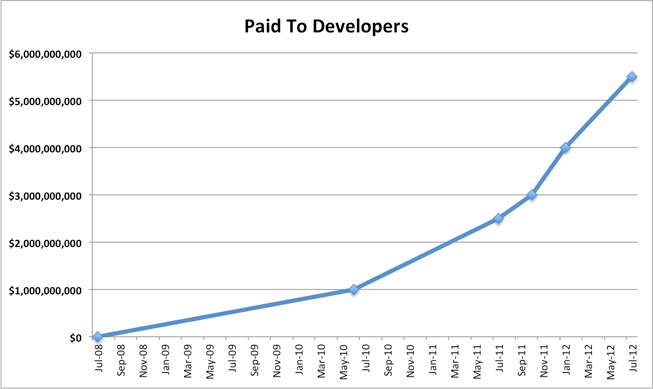There is a lot of technical information to bring back from conferences such as Apple’s iOS 5 tech talks and WWDC ‘12, but in this post I am going to focus on what I think is one of the most important topics: App Store success and the “ingredients” that make apps successful. At both conferences, plenty of emphasis was placed on great apps and how to make apps great. At first blush, discussions on the topic seemed self-congratulatory and made common sense. But in reality, it is clearly a reminder that the oft-forgotten details can make the difference between reaping the benefits of hard work and struggling to turn a profit.
The Numbers
So why are special “ingredients” necessary for App store success? Let’s first take a look at the numbers.
For the first two years since the App Store’s debut in July ’08, revenue paid to developers totaled $1 billion. In contrast to the latest figures posted by Apple, it now pays the same amount about every four months. This is great news for iOS developers. But even a great app idea is not a guarantee of monetary success if the implementation is not also great.
The 80%
Based on a survey conducted by streamingcolour.com, of the 252 game developers surveyed, the top 20 percent are bringing in 97 percent of app revenue, leaving only 3 percent for the remaining 80 percent. Digging further, it was found that the top 1 percent of developers are bringing in more than 33 percent of the revenue. Applying these statistics to Apple’s figures for the last nine months would mean an average of $18,333/month for the top 1 percent; $2,684/month for the top 20 percent; and $21/month for the remaining 80 percent.
There are many factors at play here including the crowded nature of the games category, and many different ways to monetize an app, as well as reasons not to. But it does validate something that most of us pretty much know already — there is a curve that you need to beat if you want a share of that revenue.
The Ingredients
When planning for success in the App Store, your end goal should to be to exceed the user’s expectations and get them excited about the app. An app that is fun and exciting to use, regardless of its purpose, is one that users will want to tell their friends about. Poorly implemented apps get lost in the bowels of the App Store, so you really need to go that extra mile to beat that curve. Fortunately, Apple provides some very solid guidance on the “ingredients” necessary for great apps that I’d like to share with you here.
Inviting – Make sure the app makes a great first impression. When using a great app, the device becomes the app that you are using. For example, when using the calendar app, the iPad becomes a desktop calendar; when using the maps app, the device becomes a street map. There are no encumbrances of a traditional desktop app, and a good design allows for and encourages rich interaction.
Intuitive – An app should have a clearly-defined purpose and scope, and should not try to do too much. The app should be smart, figure out as many things automatically as possible, and do one thing extremely well.
Engaging – An engaging app is one that keeps users coming back for more. You can achieve this with useful functionality, fresh content, or a combination of both. The more engaging the app, the more value it will bring to users.
Enabling – An enabling app is one that allows users to do something that couldn’t have done before or in a way that wasn’t previously possible. The portability, connectivity, and breadth of sensors on iOS devices allow for many new possibilities. For example — an augmented reality app that uses a camera in conjunction with location and orientation information to overlay useful information on what you can see.
Optimized – None of the above will matter unless the app is robust, responsive and stable. On top of that, apps that are designed to take full advantage of the latest platform capabilities and shed legacy design metaphors will have a distinct advantage in winning users over.
Accessible – One in five people have a disability. So, if your app is not designed to be accessible, you could be greatly limiting your audience.
Localized – At the time of this writing, Apple’s App Store is available to customers across 155 regions around the world. Offering apps to users in their native language will almost certainly create many more satisfied users compared to a single-language offering.
Conclusion
When launch dates loom and budgets tighten, details such as these are tempting to ignore. With increasing competition in the App Store and the immense value of being within the top few percent of app sales, these ingredients may prove increasingly important, possibly even vital, over time. Whatever stage your app idea is in, I encourage you to consider these ingredients as part of your overall plan for a successful launch.







2 Responses
Hi Kyle, I read your post with interest. The “localized” part have been something I have been thinking about. I am the author of iOrtho+. Hank has writing the code for me. Can you help me understand how to decide on the languages in which to consider translating and so idea of cost? Thank you
Hey Dawn,
Sure – we’ll be in touch. Is your app offered outside of the US? If so, I would suggest taking a look at the countries that are downloading the app and then translating it to those languages. We’ll help you figure that out and also figure out how to best cost effectively translate the app.
Talk with you soon!